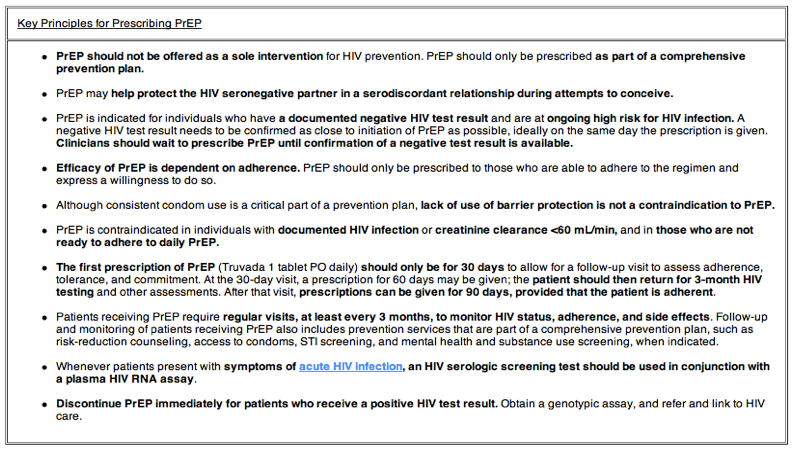| |
NYS HIV PEP/PrEP Guidance-Pre & Post Exposure Prophylaxis
|
| |
| |
1. Post-Exposure Prophylaxis
http://www.hivguidelines.org/clinical-guidelines/post-exposure-prophylaxis/
-----------------------
2. HIV Prophylaxis Following Non-Occupational Exposure
Updated July 2013.......
HIV Prophylaxis Following Non-Occupational Exposure
http://www.hivguidelines.org/clinical-guidelines/post-exposure-prophylaxis/hiv-prophylaxis-following-non-occupational-exposure/#table3
RECOMMENDATIONS:
The preferred PEP regimen is tenofovir + emtricitabine* plus raltegravir (see Table 3 for dosing and Appendix A for description of each drug). (AII) The first dose should be given as soon as possible after exposure, ideally within 2 hours. The recommended duration of PEP is 28 days. (AII)
* Lamivudine may be substituted for emtricitabine.
Recommended PEP Medications:
Tenofovir (TDF)
Emtricitabine (FTC)
Raltegravir (RAL)
Lamivudine (3TC) - equivalent substitute for emtricitabine
Alternative PEP Medications:
Atazanavir (ATV)
Lopinavir/ritonavir (LPV/r)
Darunavir (DRV)
Fosamprenavir (FPV)
Zidovudine (ZDV)
----------------------
3. NY State PrEP Guidance
NEW: Guidance for the Use of Pre-Exposure Prophylaxis (PrEP) to Prevent HIV Transmission
Posted January
2014
http://www.hivguidelines.org/clinical-guidelines/pre-exposure-prophylaxis/guidance-for-the-use-of-pre-exposure-prophylaxis-prep-to-prevent-hiv-transmission/?utm_source=Guidance for the Use of Pre-Exposure Prophylaxis to Prevent HIV Transmission&utm_campaign=PrEP&utm_medium=email
New York State Summary on Pre-Exposure Prophylaxis to Prevent HIV Infection
The New York State Department of Health AIDS Institute (NYSDOH AI) supports the addition of pre-exposure prophylaxis (PrEP) to the menu of evidence-based interventions to prevent HIV transmission. Throughout its history, the NYSDOH AI has been a leader in recommending biomedical interventions to prevent HIV infection, beginning with establishing a standard of care for the prevention of mother-to-child HIV transmission, using antiretroviral agents during pregnancy and labor and delivery, and as prophylaxis for the newborn. Since 1991, NYSDOH AI has recommended a combination of antiretroviral agents for post-exposure prophylaxis to prevent HIV transmission in the context of occupational and non-occupational exposures. NYSDOH AI has recently recommended that all patients living with HIV be evaluated for initiation of antiretroviral therapy (ART). This recommendation is based on increasing evidence that patients with established HIV infection benefit from ART at all stages of disease and on recent data that demonstrate a dramatic reduction of HIV transmission risk from ART-treated patients, which is a strategy commonly known as "treatment as prevention."
Over the past few years, studies evaluating the efficacy of PrEP have shown promising results. On the national level, the Centers for Disease Control and Prevention has issued interim guidance for men who have sex with men (MSM), heterosexually active adults, and injecting drug users in January 2011, August 2012, and June 2013, respectively. In July 2012, the Food and Drug Administration approved the use of tenofovir + emtricitabine (TDF/FTC, Truvada) for use of PrEP in adults.
Although the overall number of new HIV infections is decreasing in New York State, some subpopulations, such as young men who have sex with men (YMSM), continue to show a rise in the rate of newly acquired HIV infection. In addition, new infections continue to be disproportionately higher in communities of color. PrEP may be an effective option to augment behavior change in these high-risk populations.
The NYSDOH AI recognizes that a comprehensive system-wide approach is necessary to ensure that patients are effectively managed on PrEP, and that individuals throughout the State who will most likely benefit have access to PrEP. Key populations that are most at risk for HIV, such as MSM, serodiscordant couples, and injection drug users, should be prioritized for outreach and access to ensure that they are aware of PrEP and its benefits. In New York State, there is a broad network of community-based providers, including local health departments and STD clinics, that offer a full range of prevention, primary care, and supportive services to high-risk individuals. This network provides a firm foundation upon which to base targeted efforts to identify high risk-individuals and replicate, to the extent possible, the approaches used in the highly successful clinical trials of PrEP.
To better understand the use of TDF/FTC as PrEP, New York State will promote effective use of this biomedical intervention through this clinical guidance document, provider implementation protocols, and ongoing educational programs.
Following is a summary of the key principles that are described in this document.

|
|
| |
| |
|
|
|